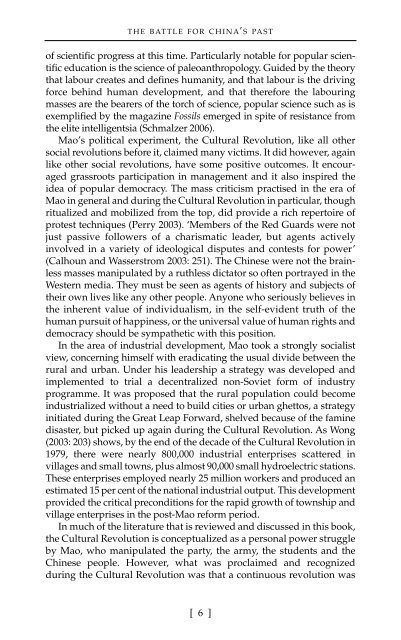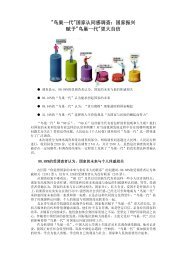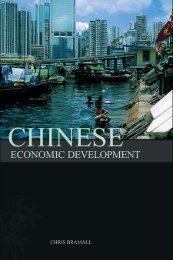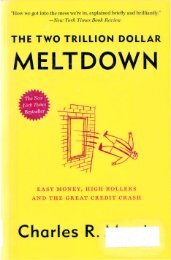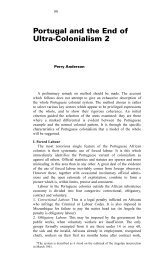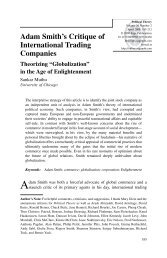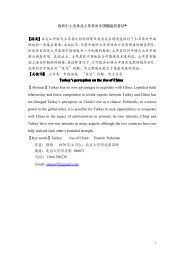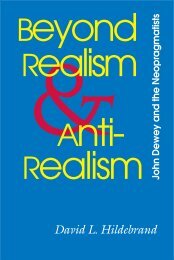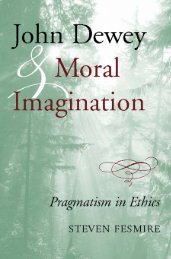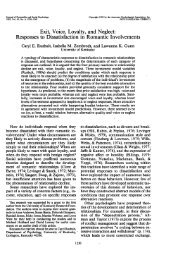Battle for China's Past : Mao and the Cultural Revolution
Battle for China's Past : Mao and the Cultural Revolution
Battle for China's Past : Mao and the Cultural Revolution
You also want an ePaper? Increase the reach of your titles
YUMPU automatically turns print PDFs into web optimized ePapers that Google loves.
THE BATTLE FOR CHINA’ S PAST<br />
of scientific progress at this time. Particularly notable <strong>for</strong> popular scientific<br />
education is <strong>the</strong> science of paleoanthropology. Guided by <strong>the</strong> <strong>the</strong>ory<br />
that labour creates <strong>and</strong> defines humanity, <strong>and</strong> that labour is <strong>the</strong> driving<br />
<strong>for</strong>ce behind human development, <strong>and</strong> that <strong>the</strong>re<strong>for</strong>e <strong>the</strong> labouring<br />
masses are <strong>the</strong> bearers of <strong>the</strong> torch of science, popular science such as is<br />
exemplified by <strong>the</strong> magazine Fossils emerged in spite of resistance from<br />
<strong>the</strong> elite intelligentsia (Schmalzer 2006).<br />
<strong>Mao</strong>’s political experiment, <strong>the</strong> <strong>Cultural</strong> <strong>Revolution</strong>, like all o<strong>the</strong>r<br />
social revolutions be<strong>for</strong>e it, claimed many victims. It did however, again<br />
like o<strong>the</strong>r social revolutions, have some positive outcomes. It encouraged<br />
grassroots participation in management <strong>and</strong> it also inspired <strong>the</strong><br />
idea of popular democracy. The mass criticism practised in <strong>the</strong> era of<br />
<strong>Mao</strong> in general <strong>and</strong> during <strong>the</strong> <strong>Cultural</strong> <strong>Revolution</strong> in particular, though<br />
ritualized <strong>and</strong> mobilized from <strong>the</strong> top, did provide a rich repertoire of<br />
protest techniques (Perry 2003). ‘Members of <strong>the</strong> Red Guards were not<br />
just passive followers of a charismatic leader, but agents actively<br />
involved in a variety of ideological disputes <strong>and</strong> contests <strong>for</strong> power’<br />
(Calhoun <strong>and</strong> Wasserstrom 2003: 251). The Chinese were not <strong>the</strong> brainless<br />
masses manipulated by a ruthless dictator so often portrayed in <strong>the</strong><br />
Western media. They must be seen as agents of history <strong>and</strong> subjects of<br />
<strong>the</strong>ir own lives like any o<strong>the</strong>r people. Anyone who seriously believes in<br />
<strong>the</strong> inherent value of individualism, in <strong>the</strong> self-evident truth of <strong>the</strong><br />
human pursuit of happiness, or <strong>the</strong> universal value of human rights <strong>and</strong><br />
democracy should be sympa<strong>the</strong>tic with this position.<br />
In <strong>the</strong> area of industrial development, <strong>Mao</strong> took a strongly socialist<br />
view, concerning himself with eradicating <strong>the</strong> usual divide between <strong>the</strong><br />
rural <strong>and</strong> urban. Under his leadership a strategy was developed <strong>and</strong><br />
implemented to trial a decentralized non-Soviet <strong>for</strong>m of industry<br />
programme. It was proposed that <strong>the</strong> rural population could become<br />
industrialized without a need to build cities or urban ghettos, a strategy<br />
initiated during <strong>the</strong> Great Leap Forward, shelved because of <strong>the</strong> famine<br />
disaster, but picked up again during <strong>the</strong> <strong>Cultural</strong> <strong>Revolution</strong>. As Wong<br />
(2003: 203) shows, by <strong>the</strong> end of <strong>the</strong> decade of <strong>the</strong> <strong>Cultural</strong> <strong>Revolution</strong> in<br />
1979, <strong>the</strong>re were nearly 800,000 industrial enterprises scattered in<br />
villages <strong>and</strong> small towns, plus almost 90,000 small hydroelectric stations.<br />
These enterprises employed nearly 25 million workers <strong>and</strong> produced an<br />
estimated 15 per cent of <strong>the</strong> national industrial output. This development<br />
provided <strong>the</strong> critical preconditions <strong>for</strong> <strong>the</strong> rapid growth of township <strong>and</strong><br />
village enterprises in <strong>the</strong> post-<strong>Mao</strong> re<strong>for</strong>m period.<br />
In much of <strong>the</strong> literature that is reviewed <strong>and</strong> discussed in this book,<br />
<strong>the</strong> <strong>Cultural</strong> <strong>Revolution</strong> is conceptualized as a personal power struggle<br />
by <strong>Mao</strong>, who manipulated <strong>the</strong> party, <strong>the</strong> army, <strong>the</strong> students <strong>and</strong> <strong>the</strong><br />
Chinese people. However, what was proclaimed <strong>and</strong> recognized<br />
during <strong>the</strong> <strong>Cultural</strong> <strong>Revolution</strong> was that a continuous revolution was<br />
[ 6 ]


